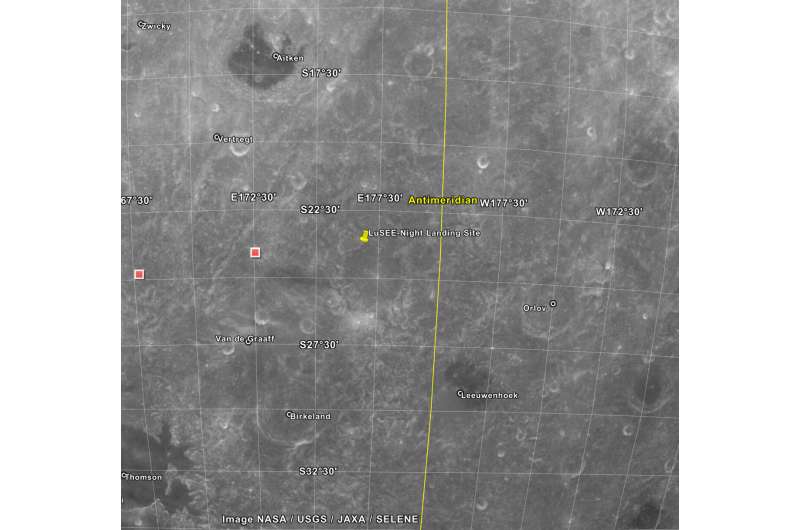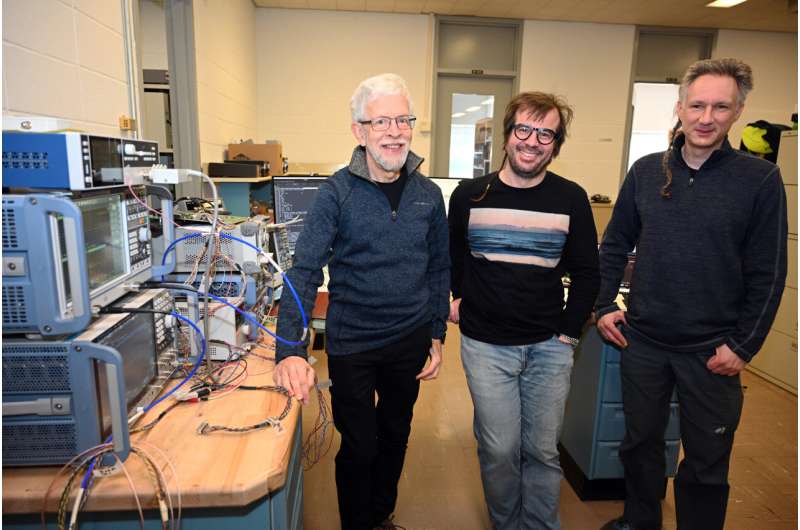This article has been reviewed according to Science X's editorial process and policies. Editors have highlighted the following attributes while ensuring the content's credibility:
fact-checked
trusted source
proofread
Lunar telescope project aims to search for ancient radio waves

Scientists at the U.S. Department of Energy's (DOE) Brookhaven National Laboratory are leading a new effort to land a radio telescope on the moon. If successful, the project will mark the first step towards exploring the Dark Ages of the universe.
The Dark Ages are an early era of cosmological history starting about 380,000 years after the Big Bang. There were no stars or planets in the Dark Ages. It's a point in time that scientists have never been able to observe. Though radio waves from the Dark Ages still linger in space, the abundance of radio interference on Earth has masked these signals from scientists seeking to study them.
If cosmologists could detect radio waves from the Dark Ages—what is known as the "Dark Ages Signal"—they could help uncover answers to some of the universe's biggest mysteries, such as the nature of dark energy or the formation of the universe itself.
"Modeling the universe is easier before stars have formed. We can calculate almost everything exactly," said Brookhaven physicist Anže Slosar. "So far, we can only make predictions about earlier stages of the universe using a benchmark called the cosmic microwave background. The Dark Ages Signal would provide a new benchmark. And if predictions based on each benchmark don't match, that means we've discovered new physics."
Now, a new project called the Lunar Surface Electromagnetics Experiment-Night (LuSEE-Night) aims to access the Dark Ages Signal for the first time. LuSEE-Night is a remarkable concept for a radio telescope that will be developed in collaboration between NASA and DOE, with Brookhaven Lab leading DOE's role in the project and DOE's Lawrence Berkeley National Lab providing key technical support.
LuSEE-Night is set to make history for its ability to reach—and survive in—an inhospitable place where there's enough radio silence for the Dark Ages Signal to be detected: the lunar far side.
Surviving the dark side of the moon
Some may know it as the "dark side of the moon," but what is scientifically known as "the lunar far side" isn't eternally dark. The lunar far side is named for its inability to be seen from Earth, but it experiences its own day and night cycle.
"The moon and Earth are tidally locked, which means that the moon rotates around its own axis with the same velocity as it does around the Earth," said Slosar, who is leading DOE's contributions to LuSEE-Night's science program and operations and is also the LuSEE-Night collaboration spokesperson. "This is why we always see the same side of the moon. But the side we can't see, the lunar far side, is shielded from many sources of radio interference at night by the moon's own mass."

Cosmologists around the world have been interested in observing the universe from the lunar far side for decades and they have attempted to reach it before. But in exchange for the radio silence the lunar far side provides, it presents a treacherous environment with little chance for scientific equipment to survive—let alone transmit data back to Earth.
The lunar far side is in total darkness for 14 Earth days followed by 14 days of brutal sunlight. That causes temperatures to fluctuate between 250 and -280 degrees Fahrenheit—and a dramatic change can happen in a matter of hours.
"The moon is easier to reach than Mars, but everything else is more challenging," said Paul O'Connor, a senior scientist in Brookhaven's Instrumentation Division and LuSEE-Night Project Instrument Scientist. "There's a reason only one robotic rover has landed on the moon in the last 50 years, while six went to Mars, which is 100 times farther away. It's a vacuum environment, which makes removing heat difficult, and there's a bunch of radiation."
LuSEE-Night must reject heat in a vacuum environment during the day and keep itself from freezing at night—all while powering itself through 14 days of continuous darkness and conducting first-of-its-kind science.
"The power has to come from a battery, which can only be so efficient based on its size," O'Connor said. "More powerful batteries are heavier, and a flight mission to the moon has a strict mass limit. We have to be very parsimonious with the power that we allocate, and it puts us in a familiar domain where we must make trade-offs between power and sensitivity."
Building world-leading scientific instrumentation under strict design requirements is a longstanding area of expertise for Brookhaven Lab's Instrumentation Division.
"We have a long history of building detector instrumentation that reaches the ultimate limits of sensitivity, whether that be for detecting subatomic particles in high energy physics experiments or ultrabright X-rays at the National Synchrotron Light Source II," O'Connor said. "Over the last 15 years we've moved toward more astrophysics applications. Most notably, Brookhaven developed the 3.2 gigapixel sensor array for the Rubin Observatory. It is the biggest charge-coupled device (CCD) array that has ever been built."
Brookhaven's leadership role in the LuSEE-Night project also brings expertise in radio cosmology. In particular, the Lab has previously demonstrated the ability to design, construct, and operate a prototype radio telescope. Physicists, engineers, and technicians from the Lab's Instrumentation Division and Physics Department collaborated to create the prototype and observe large swaths of the distant cosmos with high sensitivity.
The Lab's scientific and technical expertise is a critical combination for achieving LuSEE-Night's ambitious science goals and design requirements—particularly for developing highly sensitive radio telescopes.
"LuSEE-Night is not a standard radio telescope," Slosar said. "It's more of a radio receiver. It will work like an FM radio, picking up radio signals in a similar frequency band. The spectrometer is at the heart of it. Like a radio tuner, it can separate out radiofrequencies, and it turns signals into spectra. That's where our expertise gives us a starting point. Even though nobody has built an instrument like this before, we know how to build the most crucial component—a very sensitive spectrometer."
In addition to building the all-important spectrometer, Brookhaven is leading the DOE effort to construct the whole telescope.
"We will build out LuSEE-Night's electronics, procure the batteries, solar panels, and communications equipment, and ensure all components of the instrument are cohesive and suited for spaceflight," said Brookhaven scientist Sven Herrmann, the LuSEE-Night Construction Project Manager for DOE's part of the mission and a researcher at the Kavli Institute for Particle Astrophysics and Cosmology. "We will handle the inner equipment assembly, then ship the pieces to UC Berkeley's Space Sciences Laboratory for end integration. NASA will coordinate the launch through its Commercial Lunar Payload Services program, which leverages private companies to provide the transport to the moon ."
After touching down on the lunar far side, LuSEE-Night's lander will turn off permanently so it does not produce any interference. The telescope will then deploy four three-meter-long antennas, developed by Berkeley Lab, on a turntable for data collection. Then, LuSEE-Night must face its greatest challenge: surviving its first night on the lunar far side.
At home on Earth, scientists must patiently wait 40 days for LuSEE-Night to collect and transmit its first dataset to a relay satellite that talks to Earth. Until then, they won't know if LuSEE-Night survived.
If LuSEE-Night does survive, the collaboration will achieve its main goal: to prove that the long-sought lunar far side is accessible for radio cosmology experiments. Scientists will then have a proof-of-concept for developing a more elaborate telescope in the future that is better equipped to detect the distant Dark Ages Signal—if it's needed.
While LuSEE-Night is primarily considered a pathfinder, it is designed to collect data for two years and magnificent discoveries are possible. LuSEE-Night could exceed its main goal and detect the Dark Ages Signal on its own, or even uncover new and unexpected mysteries hidden deep in the cosmos along the way.
Provided by Brookhaven National Laboratory


















